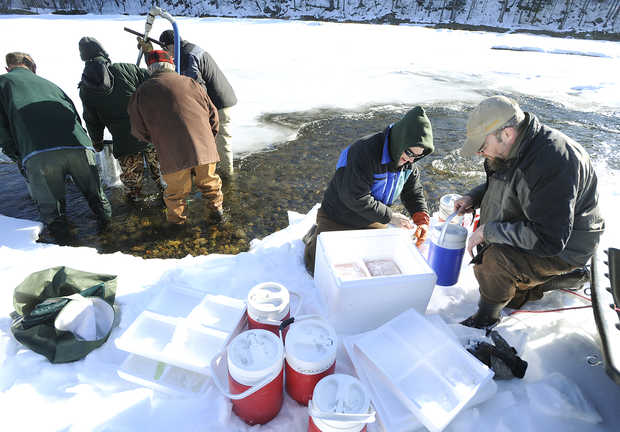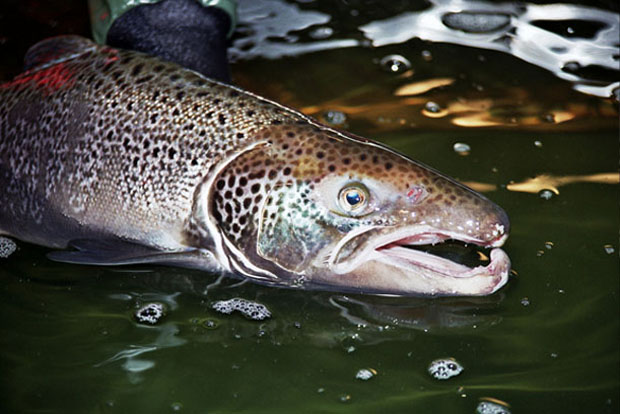Down East conservation group hopes method of ‘planting’ salmon eggs in rivers will restore population
MACHIAS, Maine

Image by Terry Karkos.
Terry Karkos – Maine marine biologist Jason Bartlett, front left, and Mark Pasterczyk prepare Atlantic salmon eggs for planting in the Sandy River in Strong, Maine.
[dropcap]A[/dropcap] salmon conservation organization is trying a new technique Down East for the first time, “planting” eggs in three rivers in the region in hopes they will hatch and grow into adult versions of Atlantic salmon.
The Downeast Salmon Federation, based in Columbia Falls, has adopted a technique that has been used successfully by state fisheries biologists in the Kennebec drainage in western Maine for about eight years. Success is measured by how many eggs hatch into fry.
The Department of Marine Resources fisheries biologists have reported nearly half the eggs emerging into fry compared with only 10-12 percent with a previous method.
Working with fisheries biologists from DMR and the U.S. Fish & Wildlife Service, federation staff planted 145,000 salmon eggs earlier this month in the beds of the Pleasant, Narraguagus and Machias rivers
“We’re quite sure that it is going to be [productive],” said Dwayne Shaw, executive director of the Downeast Salmon Federation, who discussed the project on Tuesday.
The technique simulates natural activities of salmon reproduction. A female salmon creates a nest, called a redd, in the gravel of a streambed or riverbed in the fall. Using her tail, the fish scoops out a pit, lays her eggs, then covers them with gravel to protect them until they hatch in the spring.
The biologists look for a good spawning and rearing habitat that is not covered with ice. A pump is used to make a hole in the bottom, and funnels made of PVC and stove pipe are inserted several inches into the bottom. The eggs are poured into the funnels. When the funnels are removed, the eggs are lightly covered over by the surrounding gravel.
DMR fisheries biologist Paul Christman adapted a technique for Maine that has been used in Alaska. Shaw noted that Christman has extensively researched survival rates of salmon hatched from the technique.
That research has “been very positive,” Shaw said. “Those fish do survive.”
He said that the salmon potentially would be hardier because they will emerge in the spring at the same time that food — insect life — becomes available.
Christman, who discussed the approach, said Wednesday that there is a “survival advantage” that comes with the salmon born in their natural environment.
The technique produces more juvenile fish and is on a much larger scale, said Christman, who, with other DMR biologists, has monitored the results at other stages of the salmon life cycle.
DMR biologists have used the equipment and technique to plant salmon eggs into the Sandy River, Sheepscot River, the Penobscot River and Cove Brook, which is part of the Penobscot drainage.
The summer of 2014 will be the first season for returning adult salmon that have been produced by egg planting in recent years.
“We can’t wait to see what’s going to happen this summer,” said Christman. “We’re very excited about that” and should see a run of adult salmon in the Kennebec River, he added.
Shaw said Christman assisted the Downeast Salmon Federation staff “to teach us the technique and double-check the equipment we put together.” The federation also was aided by personnel from the Craig Brook National Fish Hatchery in Orland.
The biologists from the three partner agencies planted 80,000 salmon eggs in the Narraguagus River, 45,000 in the Pleasant River and 20,000 in the Machias River. Eggs were planted north of Route 9 into the Narraguagus, a tributary of the Machias and in the vicinity of Columbia Falls into the Pleasant.
“The biggest issue is finding a good location, a place you can wade,” said Shaw. “It’s got to be safe.”



